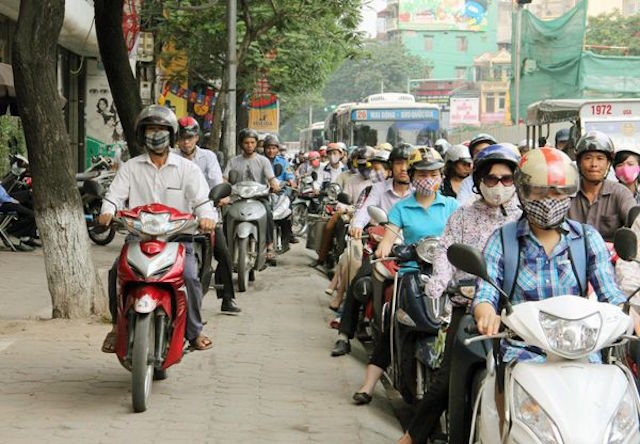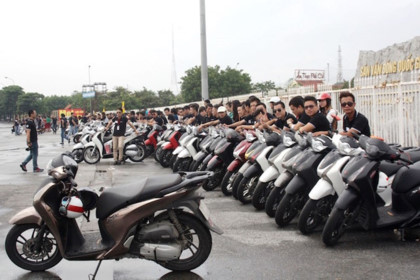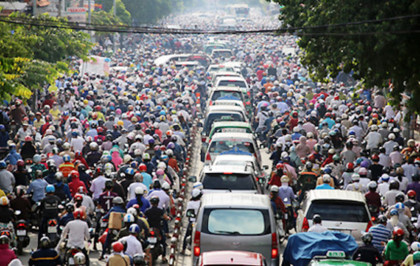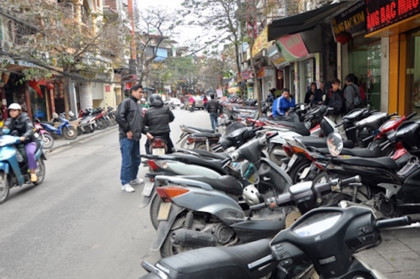Honda Vietnam makes bank on Vietnamese motorcycle market
 |
| Honda motorcycles are very popular in Vietnam |
Billion-dollar profits
2016 was a very successful year for Honda Vietnam, Vietnam’s largest motorcycle company, as its after-tax profit officially exceeded the billion-dollar mark.
This figure is calculated based on the dividends paid in proportion to the capital contribution of Vietnam Engine and Agricultural Machinery Corporation (VEAM) in Honda Vietnam.
At the end of September 2017, VEAM officially released the financial statements for its operation and business activities from January 1, 2016 to January 23, 2017.
Most noticeable in this report is the amount of dividends and profits paid to VEAM, which was equivalent to over VND10.117 trillion ($445.68 million). The largest fraction of total dividends and profits paid by this joint venture belonged to Honda Vietnam, recorded at VND7.965 trillion ($350.88 million).
Honda Vietnam was established in 1996 as a joint venture between Honda Motor (Japan), Asian Honda Motor (Thailand), and VEAM to manufacture two main products: motorcycles and automobiles. VEAM contributed 30 per cent of the chartered capital, with the remaining 70 per cent belonging to the other Honda partners.
Thus, through simple arithmetic based on the results published by VEAM, it is estimated that Honda Vietnam’s after-tax profit from the Vietnamese market was about VND24 trillion, over one billion dollars, in 2016.
The profit VEAM received from Honda Vietnam in 2014 reached VND694.2 billion ($30.58 million). By 2015 divided profits had increased to VND2.676 trillion ($117.89 million), before surging to roughly VND7.4 trillion ($325.99 million) in 2016 as publicly announced by the corporation.
The profit VEAM received from Honda Vietnam in 2014 reached VND694.2 billion ($30.58 million). By 2015 divided profits had increased to VND2.676 trillion ($117.89 million), before surging to roughly VND7.4 trillion ($325.99 million) in 2016 as publicly announced by the corporation.
In proportion with VEAM’s profit share, Honda Vietnam’s after-tax profit in 2014 was recorded at VND2.313 trillion ($101.89 million). By 2015, Honda Vietnam’s profit hit VND8.92 trillion ($392.95 million), and continued to rise to VND24.5 trillion ($1.08 billion) in 2016, as mentioned above.
Upon its establishment in March 1996, Honda Vietnam only had $62.9 million of chartered capital. Throughout its operation in Vietnam, Honda announced that it had invested more than $290 million in the first manufacturing plant, $65 million in the second plant, $120 million to build a third factory, and another $60 million in the new auto plant.
It is not difficult to see that the high profits Honda Vietnam has earned just over the last three years significantly surpassed its investments in Vietnam so far.
Good income from latest automatic models
The total production capacity of Honda Vietnam’s three motorcycle factories is 2.5 million motorcycles per year. Motorcycle sales in recent years have fluctuated between 1.9 and 2.1 million units per year, against the total 3-3.3 million units per year for the whole market.
After more than 20 years of operation in Vietnam, Honda Vietnam has sold over 20 million motorcycles and scooters, occupying about 70 per cent of the market, reaching far ahead of competitors, including Yamaha Vietnam, Suzuki Vietnam, Piaggio Vietnam or SYM.
Vietnam is also considered one of the top four markets for Honda motorcycles globally.
While Honda Vietnam is manufacturing and selling both motorcycles and automobiles, the motorcycle segment is still the dominant and most profitable business line, accounting for 85 per cent of the company’s total revenue.
 |
| Consumers love expensive automatic scooters like SH, which greatly boosted business growth |
Talking with VIR, general directors of Honda Vietnam also admitted that the company was very impressed with the voracity Vietnamese people buy and use motorcycles.
“Vietnamese people like automatic scooters and tend to shift to high-class and luxurious models. In big cities like Hanoi and Ho Chi Minh City, citizens have better living standards so high-class vehicle models kitted out with modern technology are selling well,” Minoru Kato, former general director of Honda Vietnam, said.
Besides, according to the Vietnam Association of Motorbike Manufacturers (VAMM), in 2016, the market continued to witness the significant growth of automatic scooters compared to manual transmission motorcycles.
In 2015, scooters accounted for over 55 per cent of the total sales, while manual vehicles only hovered around 45 per cent. In 2016, the proportion of scooters remained fairly stable at 50-55 per cent and continued to outnumber that of the manual transmission motorcycles sold in the market. It is forecast that scooters will make up about 60 per cent of the motorcycle market in 2018.
Yano Takeshi, president of VAMM, said that the high growth rate of scooters reflects an upward trend in the spending habits and income of Vietnamese people. Scooter sales have not only experienced rapid growth in urban areas, but also risen sharply in rural areas. In 2017, when the average income of Vietnamese people is expected to increase to about $2,600 per capita per year, the demand for high-end motorcycles will grow stronger.
Moreover, motorcycle prices also showed a tendency to increase in 2016. According to a representative of Piaggio Vietnam, the price of automatic scooters in Vietnam in 2007 reached an average VND35-40 million ($1,542-1,762) per unit, which by now has climbed to VND55-60 million ($2,423-2,643).
More promisingly, it is predicted that over the next seven years, the scooter market will grow by 50 per cent. Honda Vietnam is thriving on these trends, with automatic scooter sales exceeding manual transmission motorcycles.
Obviously, as the cost of production has not changed considerably, the increases in the proportion of automatic scooters and expensive vehicle models in production and business imply a larger number of Honda’s vehicles sold to the market and thereby higher profits for the company. This, to some extent, has reinforced Honda’s dominance in the Vietnamese market.
A fear of traffic jams
In direct proportion with the success of motorcycle manufacturers, the volume of motorcycles on the roads is increasing rapidly, especially in big cities like Hanoi and Ho Chi Minh City.
VAMM statistics show that the number of motorcycles circulating on the streets of Vietnam by the end of 2016 was about 45 million units. This means that one of every two Vietnamese individuals owned a private motorcycle.
According to the development plan for the motorcycle industry published by the Ministry of Industry and Trade in 2008, Vietnam was to have 36 million motorcycles by 2020.
However, by 2016, the number of vehicles has already reached 45 million units, exceeding the planned target by 25 per cent. Apart from difficulties in dealing with inaccurate forecasts, the market has also seen motorcycle companies going into great lengths to optimise production and business operations in order to maximise profit, regardless of the underdevelopment of transport infrastructure.
 |
| Traffic jams are a common occurrence in the two big cities |
For instance, Hanoi has more than five million motorcycles and 500,000 cars and is now at risk of huge traffic jams as the number of private vehicles is soaring. With an average annual growth rate of 10 per cent, it is projected that by 2025, Hanoi will have about 11 million motorcycles registered in the city.
In Ho Chi Minh City, the number of motorcycles is on a rapid uptake, reaching nearly 7.4 million units. Thus, it is getting more difficult for buses and other public vehicles to travel on roads as they always have to compete for space with motorcycles.
Associate Professor Pham Xuan Mai, former Dean of Traffic Engineering at Ho Chi Minh City University of Technology, also emphasised that motorcycles are the dominant vehicle type on the city’s roads. 93 per cent of travel lanes or the city’s sidewalks and pavements are intensively occupied by motorcycles.
Mai also cited statistics, saying that more than 8,000 people die and tens of thousands are injured in traffic accidents each year. 71 per cent of these accidents were caused by motorcycles (including collisions with pedestrians, other vehicles, and self-inflicted injuries).
A calculation made by experts implies that the total damage caused by motorcycles annually has reached over $6.1 billion on average, making up 13.4 per cent of the GDP of Ho Chi Minh City—pulling back the level of development by 7-8 per cent.
“Indirectly, motorcycles are slowing down the growth rate of the city,” one expert commented.
“Motorcycles are a popular form of private transport chosen by the vast majority of city commuters. However, they also cause great harm to society. China has banned motorcycles in big cities and the results suggest that it was the right step. Other places like Hong Kong, Singapore, and Myanmar have already introduced similar policies,” said Mai.
Besides, with respect to the efforts to minimise pollution and traffic congestions, limiting personal vehicles—including restrictions on motorcycles—is one of the goals set by the two big cities.
 |
| Hanoi will ban motorcycles in urban districts from 2030 |
According to the plan on Strengthening the Management of Road Vehicles to reduce traffic congestion and environmental pollution in Hanoi during the 2017-2020 period with a vision to 2030, Hanoi will record and classify the total number of motorcycles in the city by area (district), date, and type.
At the same time, local authorities will set out zones for motorcycle restrictions, which shall be commensurate with the infrastructure and service capacity of the public transport system, and step by step cease the circulation of motorcycles in urban districts by 2030.
For Ho Chi Minh City, limiting motorbikes in metropolitan areas in the near future is also being considered by loccal authorities and plans might be finalised this October.
What the stars mean:
★ Poor ★ ★ Promising ★★★ Good ★★★★ Very good ★★★★★ Exceptional
Latest News
More News
- Partnerships drive sustainable finance (January 07, 2026 | 09:23)
- FDI inflows reach $38.42 billion in 2025 (January 06, 2026 | 17:55)
- $2.1 billion Nghi Son LNG-fired thermal power plant waits for investor (January 06, 2026 | 17:51)
- GE Vernova powers up Vietnam with first 9HA gas power plant in the country (January 06, 2026 | 16:54)
- Solid finish for manufacturing after volatile year (January 06, 2026 | 08:50)
- Meiko strengthens Vietnam operations with new PCB plants (January 06, 2026 | 08:49)
- Ho Chi Minh City backs $2 billion AI data centre with dedicated task force (January 06, 2026 | 08:43)
- PM sets January deadline for high-speed rail consultant (January 06, 2026 | 08:40)
- New decree spurs on PPP implementation (December 31, 2025 | 19:01)
- Global alliance develops $1 billion AI data centre network in Vietnam (December 30, 2025 | 10:08)
















 Mobile Version
Mobile Version